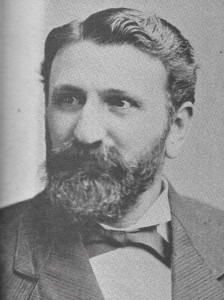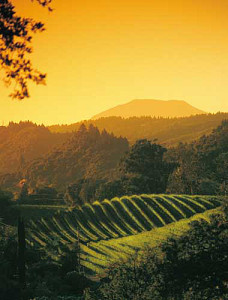
Agoston Haraszthy, pioneer wine maker, “Father of California Viticulture” & also father of Arpad Haraszthy.
In hindsight, we know Arpad Haraszthy was born to make wine. His father, Agoston Haraszthy (also known as “The Father of California Viticulture”), founded the Buena Vista Vinicultural Society in California after the 1857 establishment of his Buena Vista vineyard in Sonoma. Hungarian-American wine maker, writer and world traveler, Agoston Haraszthy moved to the United States in 1842 (when his son Arpad was only 2 years old), first settling in Wisconsin, there founding the first Wisconsin vineyards. A challenging endeavor, he gave up his attempts to grow grapes in the mid-west and moved his family to San Diego, California. Though he was active in political town-goings-on in San Diego, Agoston found he was once again disappointed in the local viticulture possibilities, and the family once more relocated to the San Francisco Bay Area, settling (this time for good) in Sonoma. To make a long (& mobile) story short, Agoston finally found what he was looking for in the Sonoma Valley. He and his family settled down. So Arpad Haraszthy grew up surrounded by wine aficionados (for example, Charles Krug was employed at the winery) – it seemed merely a matter of time before he himself entered the profession.
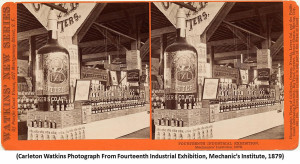
A stereoview photograph of the I. Landsberger & Co. Display of Dr. Henley’s IXL Bitters at the Mechanic’s Institute’s 14th Industrial Exhibition. A bit after Haraszthy’s time there.
However, Arpad did not immediately follow in his father’s footsteps. As a young man, Haraszthy toyed with the idea of becoming an engineer, going so far as to study engineering at the École Polytechnique, France’s then most prestigious engineering school, in 1857. Two years later, however, the young Haraszthy went north to the Champagne region to study the art of wine making. He returned to the United States in 1862, finally ready to begin his work in the vineyards of California. Arpad’s first foray into wine making was not a success, however, and his first sparkling wines were the reason for the board’s refusal to sanction his further champagne making while a member of his father’s Buena Vista Vinicultural Society. Arpad resigned from the organization. Nonetheless, Arpad persevered and, at the offer of a job in Isidor Landsberger’s wine business, moved his own young family to bustling San Francisco to try his hand at his trade once more.
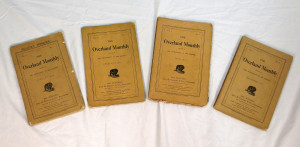
An original set of Haraszthy’s four part Overland Monthly series “Wine Making in California” is for sale on our website.
It was in San Francisco that Haraszthy and his partner developed the sparkling wine that would become California’s first commercially successful Champagne. By 1871, Arpad was not only producing very popular wines and champagnes, but was taking part in the social and academic experiences that being a wine maker afforded him. In 1871 and 1872, Overland Monthly published a four-part series of Haraszthy’s own hand, called “Wine Making in California”. This publication consisted of much research into the art of viniculture, with sections on the history of the introduction of the vine to California, the Golden State’s advantages to growing over other areas, the average prices of grapes and other materials, along with statistics in comparing European wines to California varieties. In Part Four of his research Haraszthy states, “We have endeavored to lay before the reader the true value, actual merit, and real qualities of our wines, without the slightest exaggeration… the circle will continue to narrow until California will proudly place the name of that future-discovered vineyard among those of the choicest of the earth. It will not be overshadowed by the crumbling walls of castle of monastery, whose very dampness is replete with memories… It will be the modest home of an American, surrounded by all the civilizing influences of our bright age, and with no past history but that of the peaceful, patient and noble toils of its founder!” (A copy of the original series for sale here>)
Arpad Haraszthy continued to be a well-known gentleman around the San Francisco “scene” (e.g., he was a founding member of San Francisco’s Bohemian Club), and carried on his quest to make great wines, despite the fact that the rest of his world seemed to be on the verge of collapse. His wife, Juanita Vallejo, threatened to divorce the winemaker in 1877, and only the persistent imploring of her father on her children’s behalf could dissuade her from leaving. One could only assume that Haraszthy’s social nature had led him astray, as he wrote in one letter to his wife, “With feelings of kindness, I address you this time and ask you once again to forget the past and return to me as my wife. I am not only willing but even anxious to acknowledge to you, all those errors I have committed…” In any case, Juanita returned to her husband, though only for a short time, as she unexpectedly died the following May shortly after childbirth (the child suddenly dying shortly before Juanita). Still, life went on for Haraszthy, and though he raised two children on his own for the rest of his life (he never remarried), he somehow found time to continue dazzling wine-lovers and wine makers with his viniculture research.
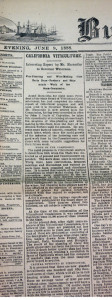
SF Evening Bulletin, June 9th, 1888. Arpad Haraszthy’s article on California Viticulture is front and center! View this item for sale here>
In 1878 Haraszthy was elected president of the State Vinicultural Society and “led its campaign for tariff protection against French wines” (Teiser and Harroun, p.10). He also became, not only a member on the Board of State Viticultural Commissioners (which he appeared before state legislature to help create), but its president. The particular cause for the Board was to rally forces against the pest known as phylloxera, which was devastating vineyards all over Europe and California. The pest was eventually vanquished (not before it had time to do significant damage), but strangely the popular Haraszthy was removed from the Board in 1888, with no reasoning (at least to present-day researchers) as to why. After his removal, Haraszthy wrote a detailed review of the Board’s endeavors throughout its first eight years.
In the last few years of his life, Haraszthy did not experience the same popularity with his sparkling wines as he had in his past. In 1900 he went on a mining trip in Alaska with his brother Bela, trying to locate other profitable sources of income, but getting ill forced him back home earlier than expected. In November of 1900, Haraszthy collapsed on a sidewalk in San Francisco on his way home from visiting a friend, and was pronounced dead on arrival at the San Francisco Receiving Hospital.
Arpad Haraszthy’s contributions to the wine-growing community of California cannot be denied any more than his father’s. As a consistent writer on wine and viniculture, he is still considered one of the most important contributors to the California wine community. His contributions were significant enough that in 1978 the Book Club of California published his 1871 – 1872 Overland Monthly essays, Wine Making in California, as a separate volume, thereby paying a modest tribute to this pillar of the California wine trade.

